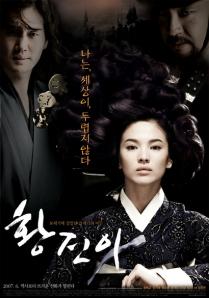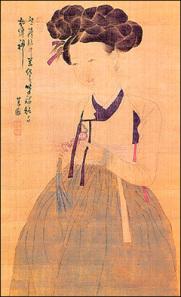Mountains are the same as in the old times,
But streams are never the same;
They keep flowing day and night,
So they can not be the same.
The men of fame are like the streams;
Once gone, they never return. - Hwang Jini
My column on the kisaeng, the Korean equivalent of geisha, opened with a sijo poem by Hwang Jini, the most famous and beloved of her profession. In recent years, she has essentially become the archetypal kisaeng, and as in the case of Western courtesans her life has provided the inspiration for novels, a television show and a movie; of course, these fictional treatments are considerably embellished and dramatized, and it’s difficult to tell history from folk legend from deliberate “improvement”. In this case, the task is further complicated by the dearth of English-language sources on the subject, but there is still enough to enable a sketch of a most unconventional woman of almost superhuman charisma who made her own way in a society where that was simply not allowed. Hwang Jini’s extraordinary presence and strength of will is a large part of why modern Korean women find her so fascinating; she is a splendid example of what I call an archeofeminist, a woman who uses her femininity to advantage rather than rejecting it.
Korean equivalent of geisha, opened with a sijo poem by Hwang Jini, the most famous and beloved of her profession. In recent years, she has essentially become the archetypal kisaeng, and as in the case of Western courtesans her life has provided the inspiration for novels, a television show and a movie; of course, these fictional treatments are considerably embellished and dramatized, and it’s difficult to tell history from folk legend from deliberate “improvement”. In this case, the task is further complicated by the dearth of English-language sources on the subject, but there is still enough to enable a sketch of a most unconventional woman of almost superhuman charisma who made her own way in a society where that was simply not allowed. Hwang Jini’s extraordinary presence and strength of will is a large part of why modern Korean women find her so fascinating; she is a splendid example of what I call an archeofeminist, a woman who uses her femininity to advantage rather than rejecting it.
She was born about 1506 in Kaesong, which lies in what is now North Korea. Her mother, Chin Hyungeum, was of the cheonmin caste, but her exact profession is unknown; some sources say she was a kisaeng herself, though this seems unlikely given her poverty. She was, however, extraordinarily beautiful, and attracted the attention of a young yangban (nobleman) named Hwang Chinsa, who took her as a mistress for a time. They had one daughter, Jini, who from a very early age was recognized as exceptional both in beauty and in musical skill; it is said that she made the decision to become a kisaeng after a young man killed himself or pined away over her, and she realized such powerful appeal would win her fortune. Now, it is very likely that the decision to send her to a kisaeng house was actually her mother’s; training started very early (sometimes as young as eight), so it hardly seems credible that she was already breaking hearts and making major life-decisions at such a tender age. However, the very fact that the legend portrays her as choosing her own destiny demonstrates the strength of the impression she made on people.
In Jini’s day, Confucianism was still solidifying its hold on the upper class, and different schools of thought were still vying for control. Though the kisaeng were technically of slave status, the government did not claim ownership of them until almost a century after her death; she therefore enjoyed a freedom later generations of kisaeng were denied. After her training was complete she set out to earn a living, taking up almost immediately with a gibu named Yi Saeng. Though some gibu were jealous or behaved pimpishly, this does not seem to have been the case with Yi Saeng, who appears to have been almost a father-figure to her. The two took a long sightseeing trip to Mount Kumgang, with Jini (who by then was using her stage name, Myeongwol [“Bright Moon”]) obtaining their needs via casual prostitution. This story illustrates several important points about her character: first, her ability even at so young an age (she was probably about 15 then) to deal with men as an equal, the hallmark of all great courtesans; second, her willingness to use her sexuality to obtain what she wanted; and third, her total lack of artificiality. The latter was her most striking characteristic: she spoke her mind freely, with little of the formality which was the norm in Korean society; she generally went without makeup at a time when most kisaeng painted their faces elaborately; and she often dressed attractively but plainly, with very little jewelry.
 But her beauty, personality, intelligence, musical talent and skill at poetry allowed her to seduce men almost without conscious effort, and when she actually applied herself she was practically an irresistible force. One of her conquests was a misogynistic government official named So Seyang, who bragged he would keep her for a month and then dismiss her without regret; at the end of the time he begged her to stay and she refused, composing a poem to tell him goodbye. Another of her famous clients was a noted musician named Yi Sajong, with whom she is said to have lived for six years; given the extremely short professional lives of the kisaeng, this was presumably in her thirties, after she had made her fortune. And a fortune it was; though it could not compare with the wealth of a yangban or even that of a successful European courtesan of her time, it was more than enough to support her in comfort until her death in 1560. One of the reasons for this success was her ability to deal with men in a completely unsentimental manner, which allowed her to always pursue the most lucrative arrangement available without hesitation or regret; this has been romantically explained as the result of a tragic love affair in her youth resulting in an inability to fall in love again, but that is almost certainly a mere fiction invented by male biographers unable or unwilling to grasp just how pragmatic a whore can be.
But her beauty, personality, intelligence, musical talent and skill at poetry allowed her to seduce men almost without conscious effort, and when she actually applied herself she was practically an irresistible force. One of her conquests was a misogynistic government official named So Seyang, who bragged he would keep her for a month and then dismiss her without regret; at the end of the time he begged her to stay and she refused, composing a poem to tell him goodbye. Another of her famous clients was a noted musician named Yi Sajong, with whom she is said to have lived for six years; given the extremely short professional lives of the kisaeng, this was presumably in her thirties, after she had made her fortune. And a fortune it was; though it could not compare with the wealth of a yangban or even that of a successful European courtesan of her time, it was more than enough to support her in comfort until her death in 1560. One of the reasons for this success was her ability to deal with men in a completely unsentimental manner, which allowed her to always pursue the most lucrative arrangement available without hesitation or regret; this has been romantically explained as the result of a tragic love affair in her youth resulting in an inability to fall in love again, but that is almost certainly a mere fiction invented by male biographers unable or unwilling to grasp just how pragmatic a whore can be.
There was only one man in her life who seemed to rise above the level of friend or valued client, and that was the philosopher Seo Kyung Duk, under whom she studied for a time. He was the only man said to have been impervious to her charms, and though she may have at first viewed him as a challenge she eventually came to admire his strength and steadfastness: she is known to have described him as one of the “three wonders of Kaesong”, the other two being the Pakyon Falls and herself (modesty was clearly not among her virtues). Though she left her home at a young age, she returned for a number of visits over the years; it was a place of great natural beauty, and her appreciation for such is demonstrated not only in her poetry and her trip to Mount Kumgang (at a time when she could have been occupied far more productively), but also in the fact that she asked to be buried in a simple grave on a riverbank in Kaesong. She wished to die in the same way she had lived: practically, honestly, and without the ceremony and pretense which was the norm in her society.
